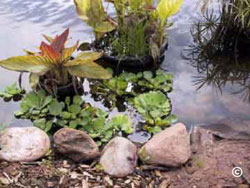A heavy clay loam soil, which is found under typical Kentucky bluegrass lawns in most parts of Colorado, is the preferred growing medium for waterlilies and other aquatic plants. Avoid using soil mixes that contain peat, perlite, bark or other light materials which will float.
A pot measuring 12 inches across and ten inches deep is adequate for most aquatics. Larger varieties such as Victoria waterlilies and red-stemmed thalias will require larger containers.
When potting aquatics, it’s best to work in a shaded area. It’s also advisable to moisten the soil first.
It’s best to pot up hardy waterlilies from mid-April through May. Plant them with the cut end of the rhizome at the edge of the container and the growing point angled above the soil line (a 45 degree angle is best) pointing toward the center of the pot.
Start potting up tropical waterlilies in mid-June, or when you can reasonably expect the water temperatures to remain 68 degrees Fahrenheit or higher. Like most marginal or shoreline plants, they should be planted near the center of the container with the crown just above the soil surface.
Ideally, waterlilies should be lodged in a pond or water feature with eight to 12 inches of water above the crown of the plant, while most marginal plants will grow best with 1-4 inches of water over the crown. Firm the soil and sink the potted plant slowly into the water. Placing pea gravel or sand on the soil surface is an optional cosmetic measure. However, placing larger rocks carefully around the surface of the potted plant can prevent the plant from dislodging before it is rooted in and can also keep fish from uprooting the plant.



